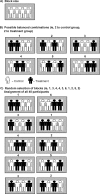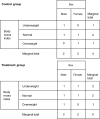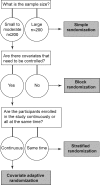Issues in outcomes research: an overview of randomization techniques for clinical trials
- PMID: 18345348
- PMCID: PMC2267325
- DOI: 10.4085/1062-6050-43.2.215
Issues in outcomes research: an overview of randomization techniques for clinical trials
Abstract
Objective: To review and describe randomization techniques used in clinical trials, including simple, block, stratified, and covariate adaptive techniques.
Background: Clinical trials are required to establish treatment efficacy of many athletic training procedures. In the past, we have relied on evidence of questionable scientific merit to aid the determination of treatment choices. Interest in evidence-based practice is growing rapidly within the athletic training profession, placing greater emphasis on the importance of well-conducted clinical trials. One critical component of clinical trials that strengthens results is random assignment of participants to control and treatment groups. Although randomization appears to be a simple concept, issues of balancing sample sizes and controlling the influence of covariates a priori are important. Various techniques have been developed to account for these issues, including block, stratified randomization, and covariate adaptive techniques.
Advantages: Athletic training researchers and scholarly clinicians can use the information presented in this article to better conduct and interpret the results of clinical trials. Implementing these techniques will increase the power and validity of findings of athletic medicine clinical trials, which will ultimately improve the quality of care provided.
Keywords: block randomization; covariate adaptive randomization; minimization; simple randomization; stratified randomization.
Figures






References
-
- Request for proposals: evidence-based practice and outcomes of care in athletic training. National Athletic Trainers' Association Research & Education Foundation. http://www.natafoundation.org/pdfs/Evidence-BasedPractice20and20Outcomes.... Accessed December 24, 2006.
-
- Singer J.D, Willett J.B. Applied Longitudinal Data Analysis: Modeling Change and Event Occurrence. New York, NY: Oxford University Press; 2003. pp. 3–15.
-
- McEntegart D.J. The pursuit of balance using stratified and dynamic randomization techniques: an overview. Drug Inf J. 2003;37(3):293–308.
Publication types
MeSH terms
LinkOut - more resources
Full Text Sources
Other Literature Sources
Medical
Miscellaneous

